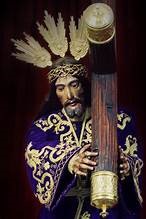“We got your God, we got your God!” echoes of these words rampage throughout the city of Mamora, an old African town on the Atlantic coast, eight kilometers from the city of Kenitra. Eighty thousand Moors, under King Fez, Muley Ismael, marched into the little Christian town of Mamora and into the city’s small parish destroying and ransacking everything Catholic from its baroque church to its intricate Spanish images. One of them, of interest to the Moors, was the statue of the Nazorean Jesus, a 5-and-a-half-foot figure of Jesus carrying his cross. They have figured out that that image, though appearing to be suffering, was the “God of the Christians.” So together with the captive civilians, the Moors took the statue, removed its cross, and crossed the image’s hand like the other captives. They then processed into the city chanting “We got your God; we got your God!” and presented to their King Muley these “offerings” together with their precious wooden god, the Nazorean.
Fr. Pedro de Los Angeles, a Trinitarian, hearing the invasion, set out to bargain with the King of Fez, Muley, in the hope of ransoming the captive Christians. He made a deal with the king to salvage them in exchange for Muslims imprisoned in Spain. Hearing the good deal, the King agreed, and the transaction was made.
However, the King remembered the image his soldiers took in the city so he asked the good Trinitarian, “How about your God?” asked the King, “We can buy them for gold” responded Fr. Pedro as the King seemed to be impressed. “Gold for its weight” the King bargained as he looked at the priest. “Give me the number of golds corresponding to its weight” the King added. Fearing that there would be not enough money for the statue of Jesus, Fr. Pedro prayed to the Most Holy Trinity and so when the Moors placed the image of Jesus on the scale and balanced it for its weight, they were all shocked as the 5-and-a-half-foot solid wooden image of Jesus the Nazorean weighted less than a coin.
Fr. Pedro managed to bring all the captive civilians and the image of Jesus to Ceuta, a former territory of Spain in Africa near the borders of Morocco, and there celebrated the liberation of the captive Christians and the ransoming of the image of Jesus. As a custom of the Trinitarians, all those who were liberated, even the statue of Jesus the Nazorean, receive a Trinitarian scapular as a witness to the providence of the Most Holy Trinity. The following days were devoted to the procession of the redeemed image of Jesus in the entire town with the crowd cheering “Hesus de cautivo!” The week-long celebration was concluded with the enthronement of the image to the sanctuary of the monastery.
Devotions and stories about the miraculous image of Jesus now called Hesus de cautivo reached its popularity in Spain. The image was transferred to various Trinitarian parishes and monasteries and every time it was enthroned, people were thrilled, and miracles were recorded. Years passed and the custody of the image and the Parish where it is now in Andalusia were given to the Franciscans. Yet, even if it is not in the hands of the Trinitarians anymore, the red and blue scapular remains to signify the story of redemption and intervention of God in human history.
There was a little anecdote about the red and blue scapular on the image. It was said that there was an attempt to remove it, but when the people found it out the next day, they protested. To avoid conflict and in adherence to the clamor of the people the scapular were put back to the image.
Today, the Trinitarians celebrate the feast of Our Holy Redeemer in memory of one of the most successful missionary activities in the Order’s history. It is named the feast of the “Holy Redeemer” not because of the Trinitarians’ work, but God’s continuous salvific intervention in history. That is why the Trinitarian collect today says “You continue to redeem us, free us from all forms of slavery that we may love you…” a plea for God’s continuous salvific love for all of us. We may not have the same captivity as the town of Mamora today, but we are surely imprisoned in various forms of modern captivity today, substance abuse, human trafficking, slavery, wars, religious persecution, and yes even technology.
Hence it is a good way today to ask ourselves in the feast of the Holy Redeemer, who got my God? Or Who is my God? For it may not be our God who is lost, but we who are in need of ransoming. We may never hear the same chant again of the Moors “We got your God; we got your God” for it is not God that is lost and in need of redeeming, but us.
BIBLIOGRAPHY
Order of the Most Holy Trinity and of the Captives. Liturgy of the Hours of the Order of the Most Holy Trinity and of the Captives. Rome: Trinitarian Publications, 1996.
General Secretariat of the Trinitarians. Trinitarian Meditations. Rome: Trinitarian Publications, 2005.
Witko, Andrew. The Order of the Holy Trinity and Captives. Trans. Ewa Swidzinska Lay, O.SS.T., Ter. And Kevin R. Lay, O.SS.T., Ter. Krakow: Wydawnictwo AA: 2009.


